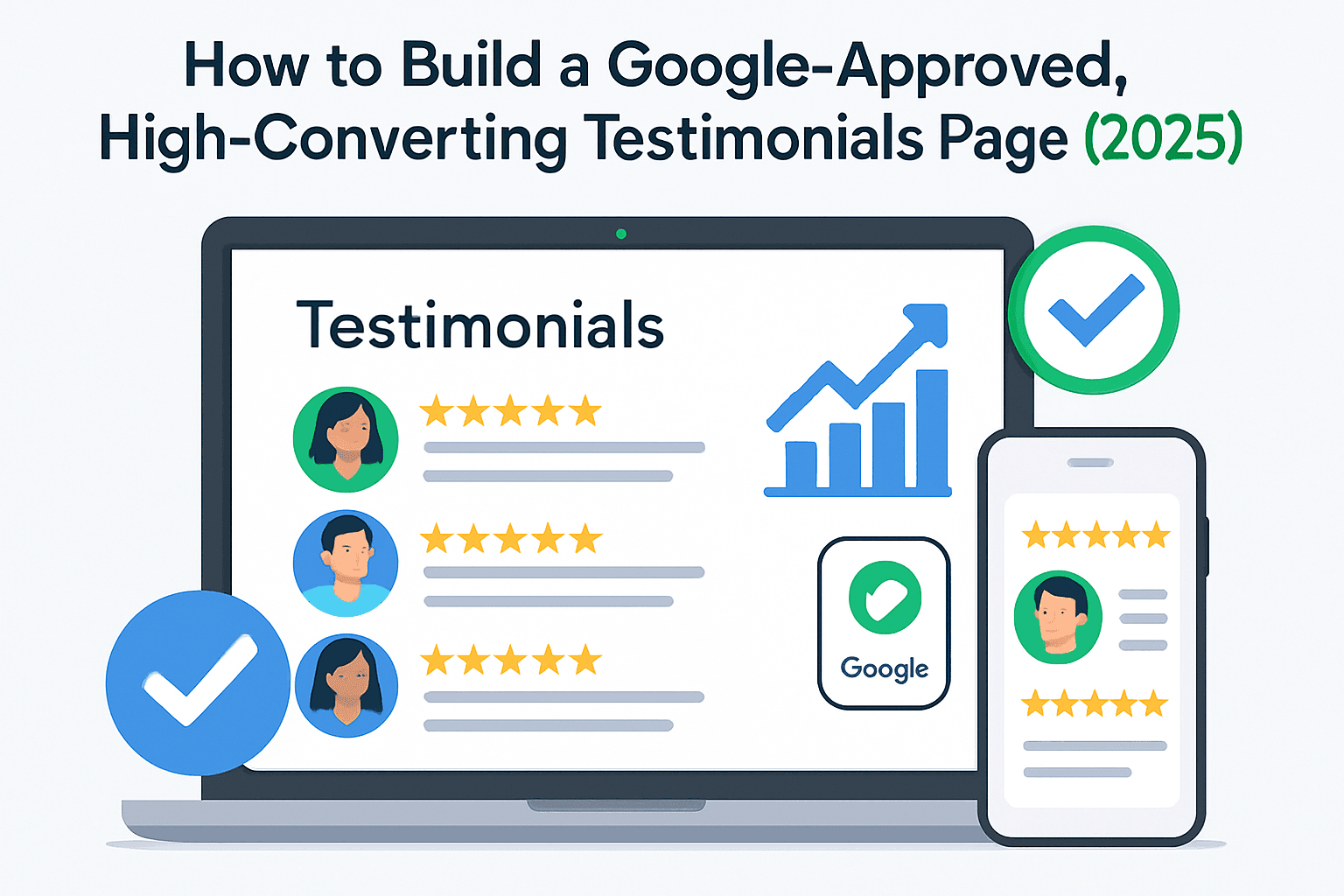Table of Contents
How to Build a Google-Approved, High-Converting Testimonials Page (2025)
A research-backed, technical and editorial framework to maximize trust, visibility, and conversions.

Social proof is one of the strongest purchase drivers—and Google increasingly evaluates how credible, verifiable, and user-centric your testimonials are. This guide distills up-to-date best practices across E-E-A-T, structured data, FTC compliance, UX, and performance so you can build a testimonials page that ranks, earns trust, and converts.
What Google Rewards on Testimonials Pages
Google favors pages that demonstrate real experience, clear provenance, and helpful, verifiable information.
E-E-A-T and verifiability
Anchor each testimonial to a real person and context: full name, role, company, industry, and (where permitted) a link to a public profile or company domain. See Google's Search Quality Rater Guidelines for what signals trust and experience [PDF].
Structured data with realistic expectations
Use review-related structured data to help Google understand your content. Start with the official Review snippet documentation (Google Search Central) and Schema.org types like Review and AggregateRating. Note that Google limits review rich results in certain "self-serving" cases—your structured data may be processed without guaranteed star snippets.
Compliance and authenticity
Follow the FTC Endorsement Guides (16 CFR Part 255) for disclosures, typical results, and no fake or suppressed reviews (FTC). Also review Google's spam policies related to deceptive practices (Google Search Essentials – Spam Policies).
Experience and page quality
Great testimonials still need great page experience. Optimize for Core Web Vitals (web.dev/vitals): fast LCP, stable CLS, responsive INP. Performance and UX are foundational ranking and conversion drivers.
Information Architecture that Converts
Organize testimonials so users can find relevant proof quickly and search engines can understand topical depth.
Segment by use case, industry, and company size
Group testimonials into facets like "B2B SaaS," "Agencies," "Ecommerce," or by job role. Add on-page filters to let buyers surface context-matching proof instantly.
Enrich every testimonial with attribution
Include name, title, company, headshot (with consent), sector, and project summary. If the quote references quantifiable outcomes, clarify the time frame and baseline.
Link out for credibility
Where possible, link to the customer's website or public profile. Outbound links to legitimate sources improve user trust and provide helpful context. See the SEO Starter Guide for internal linking best practices (Google Search Central).
Acquiring and Moderating Reviews the Right Way
A scalable, compliant acquisition workflow produces steady, trustworthy social proof.
Request flow and incentives with disclosure
Automate post-success milestone requests (e.g., after onboarding or key wins). If any perk is offered (discounts, gift cards), disclose that fact per FTC guidance (FTC FAQs).
Third‑party platforms and portability
Encourage reviews on independent platforms (e.g., G2, Capterra) for additional trust. Where terms allow, excerpt on-site with attribution. Self-serving "on your own homepage" reviews may not produce review stars in SERPs—set expectations appropriately (Google Review Snippet).
Moderation and fraud controls
Never fabricate, suppress, or cherry-pick unfairly. Publish a clear moderation policy, retain negative-but-constructive feedback, and prohibit employee/conflict-of-interest endorsements without conspicuous disclosure (FTC 16 CFR Part 255).
On‑Page SEO Essentials for Testimonials
Marry social proof with strong SEO fundamentals.
Compelling title and metadata
Craft a title that aligns with intent (e.g., "Testimonials & Case Results from B2B SaaS Teams"). Write a benefit-led meta description. Reference Google's SEO Starter Guide (Google Search Central).
Internal linking and contextual CTAs
Deep-link from each testimonial to the relevant product/feature or case study. Insert contextual CTAs near proof blocks ("See how we automate PSEO for agencies").
Evidence formatting and accessibility
Use blockquotes, pull quotes, and logos. Provide alt text for images and ensure color contrast for legibility. Good accessibility supports UX and indirectly SEO.
Structured Data: Practical Implementation
Use JSON‑LD, validate routinely, and accept that eligibility ≠ guaranteed rich results.
JSON‑LD and validation
Implement JSON‑LD per Google guidance (Review snippet docs). Validate with the Rich Results Test and Schema Markup Validator.
Recommended types and patterns
For software/services, combine an ItemList of Review with page‑level AggregateRating when you have enough volume and transparent methodology. Reference product/offer pages with consistent identifiers.
Disclosure and realistic ratings
Keep rating scales consistent (e.g., 1–5), include review dates, and avoid gating. Clearly disclose collection methods when relevant (FTC).
Performance, UX, and Trust Signals
Speed and usability compound the impact of social proof.
Core Web Vitals
Optimize for LCP, CLS, and INP (web.dev/vitals). Use responsive images, lazy loading, preconnects, and reduce render‑blocking.
Security and transparency
Serve over HTTPS, display privacy and data-use notices for review collection, and show trust badges only when verifiable.
Empirical lift from reviews
Displaying reviews can materially increase conversion rates; see research from Northwestern University's Spiegel Research Center (Spiegel Research Center). Also review annual consumer behavior insights (BrightLocal – Local Consumer Review Survey).
Measurement and Iteration
Treat your testimonials page as a performance asset.
KPIs
Track assisted conversions, CTA clicks near testimonials, scroll depth, filter usage, dwell time, and micro‑engagements with proof blocks.
A/B testing
Test quote length, ordering (recency vs. relevance), headshots vs. logos, placement of CTAs, and inclusion of quantified results.
Content operations
Set SLAs for refresh (e.g., add 3–5 new testimonials monthly), audit recency/bias quarterly, and rotate industry‑specific proof seasonally.
Conclusion
A best‑in‑class testimonials page blends authentic social proof, compliant collection practices, strong IA, validated structured data, and top‑tier performance. Build verifiable trust, help users self‑identify with relevant examples, and keep expectations realistic about rich results while following Google and FTC guidance. The result: higher credibility, better rankings, and more conversions.
Want a production‑ready testimonials page with compliant structured data and PSEO‑friendly IA? Request a free audit—our team will map your proof assets to the journeys that convert.